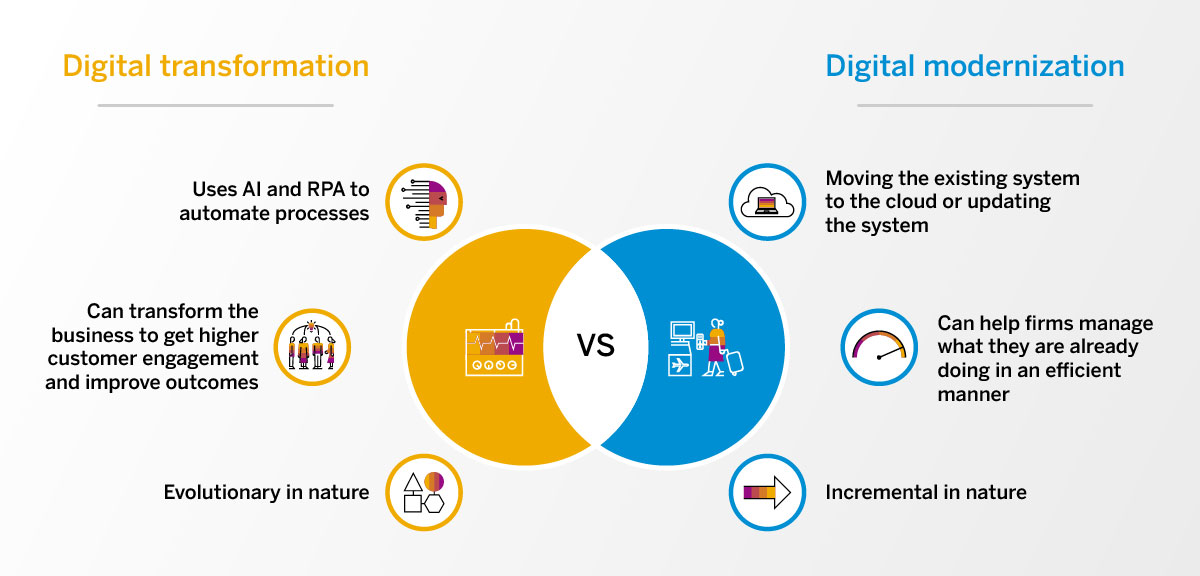Businesses have realized the importance of undergoing digital transformation. In fact, digital transformation has enabled companies to mitigate pandemic-induced disruptions. A strategic, long-term digital transformation program can help a company negotiate changing market conditions and explore new opportunities.
While successful digital transformation can help realize the potential of your company, it is also true that many digital transformation initiatives fail. Only 30% of digital transformation projects fulfill expectations, while a great majority fall short, reveals research from Boston Consulting Group.

- Confusing digital transformation with digital modernization
If the employees and management are confused regarding their goals, the transformation process is most likely to end in failure. Digital transformation and digital modernization are two different things with completely different objectives.
|
Digital Transformation |
Digital Modernization |
|
|
|
|
|
|

- Having unrealistic expectations from the digital transformation journey
Before embarking on your digital transformation journey, you should try and understand the need for it and set clear and realistic expectations from the process. This should be done in collaboration with all stakeholders involved. It is possible that a problem you are looking to solve is in no way connected to digital business transformation. It will save you money and effort in the long term if you can clearly identify and set achievable yet aspirational goals for your business.
- Weak governance structure of the digital business transformation team
A common error that many companies commit is to entirely outsource the process of digital transformation and only involve the CEO from the organization’s side. This might prove to be counter-productive; it is always a wise decision to involve the CIO as well. An even better strategy is to hire a Chief Transformation Officer (CTO) if your budget permits. The advantages of having a full-time CTO are as follows:
- Ensures continuity of process even if the CEO and CIO have busy schedules.
- Allows a top-down and deeper understanding of the process.
- Enables a smoother transformation in a cross-functional manner, by connecting people, data, and infrastructure.
- Can better anticipate changes and roadblocks.
- Resistance to change and talent gap in the organization
Before starting the journey to digital, the CEO should chalk out a strategy with the CIO and understand if the business is ready for digital transformation.
- It is possible that digital transformation is not necessary or useful for some parts of the business. To avoid disruption, transformation should be attempted in a step-by-step manner
- Employees might be apprehensive about the change and might not feel ready to embrace digital technologies. They should be given adequate training and reassurance from the top management
- New employees might need to be hired, depending on the skill set of existing employees
Pushing transformation without listening to issues and doubts is likely to hamper the process. The organization should conduct weekly meetings to answer questions and address concerns of employees. Employee leaders can be identified from different departments to ensure open-ended communication and drive the change process.
All in all, the management should create a digital-first culture that eliminates silos, encourages collaboration, and relies on communication to generate new ideas.
- Lack of participation of top management
It is necessary that the top management is involved and fully invested in the transformation. For example, during a merger between two companies, it is seen that the top management leads from the front and smoothens the transition. Similarly, when the process of digital business transformation is started, the management should explain the process in detail to the employees.
It is imperative that employees understand the expected outcome of the transformational efforts and how it’s aligned to the company vision and business goals. The following steps will make such alignment a reality:
- Detailed briefing by top management regarding the goals and targets of the transformation
- Discussing detailed plan of expectations from employees and how they can contribute to the process
- Discussing timeline of process breakdown and consequent changes
- Aiming for ‘wholesale’ transformation instead of incremental changes
A rapid enforcement of huge changes is certain to face a backlash. If the employee doubts the benefits, they are bound to be disengaged and resist change. A better strategy is to take baby steps. A good way to start would be a proof of concept, commonly used in AI projects where minor parts of the project are assessed for accuracy. Companies can be more successful in the long run by taking small steps – testing, rewriting, and testing again until the desired outcomes are achieved. To do so:
- The process should be broken down into small targets
- Each target should pertain to solving an issue, with the benefits being clearly visible
- Each achievement should be shared with employees, along with corresponding data
- Employee engagement should continue for some time and the big picture should be made clear to them
- Lack of communication between different departments
A normal business is divided into different departments, most of which are isolated islands of work that interact with each other only in rare cases. For successful digital transformation, there needs to be effective communication between different departments and different teams. This can be possible only when each department understands the process in its entirety and coordinates with others to achieve the targets. Apart from a two-way communication process between separate teams, cross-functional teams should also be set to help innovation and ideas work in a seamless way.
- Lack of resources
Concerns about prices and the organization’s financial stability are one of the most significant impediments to digital transformation. Without major adjustments or forward movement, the cost can swiftly derail progressive talks and drive decision-makers back to old problems about accruing technological debt.
IT teams are frequently overburdened, and they may be too preoccupied with ‘keeping the lights on’ to invest the time and resources required to innovate and develop a strong business case that validates a new project and helps get the funding it requires.
However, delaying digital transformation might be the end of many businesses’ chances of survival. To ensure that the company’s performance improves, business executives must be shown the business benefits of digital transformation. They must be made aware of the dangers of inaction.
- Legacy system
Legacy systems arise from the company’s efforts to modernize in the past. These result in a number of apps and systems that must be maintained indefinitely and taken into account before any innovation can be implemented. This can be a huge barrier because of the following reasons:
- Lack of current infrastructure capability to pass on big changes
- Time associated with changing existing infrastructure
- Cost associated with upgrading the infrastructure
- Lack of technical capability of staff with new infrastructure
Businesses can begin by concentrating on processes that might be improved to provide the most bang for your buck. A good first step, for example, is migrating your email server to a cloud-hosted service. This is a simple process that has an immediate payoff. Small victories like this can boost confidence while also removing legacy systems from the organization.
Finally, you need to understand that no matter how well you achieve the identified objectives, new goals will emerge from time to time. Similarly, digital transformation is an ongoing process, which the culture of the company needs to support. If the ethos of the company can ensure that change is an ongoing process, the company is truly transformed digitally.
To sum up, the bottom line can be summarized as follows:
- Change management needs leadership from the top
- Well-defined roles are important apart from the management contribution. New hires like CTO and digital specialists can go a long way in enabling a smooth digital transformation
- Coordination from employees is of utmost importance
- The ethos of the company needs to be transformed to accept digital change on an ongoing basis
- Feedback from employees on a regular basis is of utmost importance
- Incremental goals (and not transformational goals) can go a long way to ensure success
- Although the company works in different departments, understanding that the company is integrated, and cross functional teams is of critical importance
Finally, you need to ensure that your firm has a good partner to help your firm transform digitally. You need a partner who has robust experience and a clear road map in place that also takes into account the unique needs of your business as well as your constraints. With SAP Transformation Navigator, you can be assured of a long-standing and fruitful relationship in your digital transformation journey.



